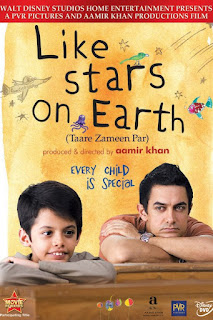FILM
REVIEW
Taare Zameen Par (titled Like Stars on Earth for Disney's international DVD) is a 2007 Indian drama film, starring Darsheel Safary as eight-year-old Ishaan, and director-producer Aamir Khan as his art teacher. Creative Director and writer Amole Gupte initially developed the idea with his wife Deepa Bhatia, who served as the film's editor. Visual effects are by Tata Elxsi's Visual Computing Labs, and the title animation—the first use of claymation in a Bollywood film—was created by Dhimant Vyas. Shankar–Ehsaan–Loy composed the film's score, and Prasoon Joshi wrote the lyrics for many of the songs. Principal photography took place in Mumbai and in Panchgani’s New Era High School, and some of the school's students make appearances.
The film explores the
life and imagination of Ishaan, an eight-year-old dyslexic child. Although he excels in art, his poor academic
performance leads his parents to send him to a boarding school. Ishaan's new art teacher suspects that he is dyslexic
and helps him to overcome his disability
|
A publicity poster based on a scene from the film. Khan knew
immediately when setting up the shot—part of the montage that details
Ishaan's tutoring by Nikumbh—that it would be the "key art of the film".
Khan noted, "This one shot tells you the entire story."[1]
|
|
Like Stars on Earth
|
|
Directed by
|
|
Produced by
|
Aamir Khan
|
Written by
|
Amole Gupte
|
Starring
|
|
Music by
|
|
Cinematography
|
Setu
|
Edited by
|
|
Distributed by
|
India:
Aamir Khan Productions(film) UTV Home Entertainment(DVD) International: PVR Pictures (film) Buena Vista Home Entertainment (DVD) |
Release dates
|
·
21 December 2007
|
Running time
|
|
Country
|
India
|
Language
|
|
Budget
|
|
Box office
|
|





No comments:
Post a Comment